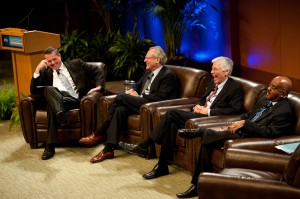He spoke at a panel discussion with two other children’s hospitals’ CEOs—Boston Children’s Hospital’s outgoing CEO James Mandell, MD, and Herman Gray, CEO of Children’s Hospital of Michigan (CHM)—during Boston Children’s Pediatric Health Innovation Summit + Awards on September 27 in Boston. Erik Halvorsen, PhD, director of Boston Children’s Technology and Innovation Development Office, moderated the session on the top challenges in pediatric health care and care delivery.
“For us to continue to support our missions in the traditional manner and for us to continue to advance pediatric health care, we need to change everything, including the reimbursement and research-funding models, as well as the education of our new caregivers,” Altschuler said. In his estimation, medical education has “unprepared new doctors and nurses to practice appropriate medicine in a safe, effective manner. The education is completely out of touch with reality.”
Gray added that not enough people are going into pediatric subspecialties, partly due to student loan burden, so too few caregivers are being trained to meet future needs. “Where is the next generation of pediatric investigators and clinicians going to come from?”
Financial woes
Compounding the gap in medical education, research funding from government sources, including the National Institutes of Health, is entering a cycle of dramatic decreases. “This decrease puts the [pediatric] academic research enterprise in peril. You can’t support a system where the average number of research applicants who consistently receive grant funding is 7 percent,” said Altschuler.
To counteract this funding loss, Altschuler recommended training in entrepreneurship for researchers.
All panelists concurred that the current fee-for-service reimbursement model will be changing soon. Altschuler predicted that this change may cause some physicians to retire, but also will force children’s hospitals “to find new revenue sources” focused on disease prevention—citing as examples new vaccinations and in utero procedures to prevent or minimize disease.
Changes in pediatric medicine itself may accelerate the changes brought by reimbursement models, Mandell concurred. “The pediatric patients who are in the hospital today are dramatically different than who will be in the hospital in 20 years due to recent innovations,” he said. “Currently, there is no revenue model that reimburses for preventive approaches, so it becomes difficult to use a clinical enterprise to support our missions. We’re going to have to tackle these issues head-on to get the disparity resolved.”
Gray stressed this point even further: “Finances are our number one challenge. Where will the resources be coming from? What’s the appropriate reimbursement model? How will the Affordable Care Act change our landscape?” Seventy percent of the patients who present to CHM are on Medicaid, for example; how reimbursement will change if they are covered by a health insurance exchange is an open question.
There are 50 to 55 large children’s hospitals in the U.S., which have varying levels of resources available to tap, which run the gamut of resources available, Gray explained. “We have challenges today in financially supporting the academic and research activities that help catalyze innovation in the future.”
Partnerships and data sharing
Mandell stressed that pediatric caregivers and the standalone hospitals cannot do this alone. “We need to foster partnerships, with each other and with industry.”
The children’s hospital industry is at “a tipping point,” but partnerships offer innovative opportunities, said Altschuler. For instance, the Children’s Hospital Association has formed a common group purchasing organization (GPO) that includes 38 children’s hospitals and a buying power of $3 billion that can help reduce costs. This GPO could be the start of an integrated database that uses administrative data for benchmark purposes. Sharing of non-financial resources, including internal review boards, biorepository labs and data, is another means to cut overhead and possibly improve care.
Other unique solutions have presented themselves through industry ventures for genomics, such as CHOP’s with the Beijing Genomics Institute and Boston Children’s with Claritas Genomics. CHOP is also exploring ventures with large pharmaceutical manufacturers.
Partnerships should work to get right people in hospitals the right information at the right time, said Mandell. “We need to collaboratively ensure that data gets collected, analyzed and disseminated appropriately,” he said. “Our commitment to this could counteract some of the negative forces impacting pediatric care.”
Healthy competition?
On one subject—competition—the panelists weren’t entirely in agreement.
“The thing that will stop innovation is if we use data to compete with each other,” said Mandell.
“We are competitors, but competition isn’t all bad,” countered Gray. “Children’s hospitals are unique resources, and we need to propel each other forward.”
“However, if you start to see children’s hospitals merge with adult facilities for sustainability, those types of partnerships could be at the peril of care provided,” said Altschuler.
Altschuler and Mandell also spoke to some of the global partnerships that have formed, and how these have provided unique revenue sources. Of CHOP’s $2.2 billion annual revenue, approximately $100 million comes from international efforts.
Despite some external negative forces, pediatric care comes down to its unique caregivers, and it’s important to keep the next generations of residents and physicians excited about pediatric medicine, said Gray. “We still have to help them feel the wonder of what they do.”








